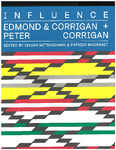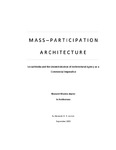Arhitectura 1950-1989. Interstitial Spaces of Communist Romanian Architecture
| dc.contributor.supervisor | Murrani, Sana | |
| dc.contributor.author | Popovici, Ioana Cristina | |
| dc.contributor.other | School of Art, Design and Architecture | en_US |
| dc.date.accessioned | 2019-07-23T11:31:37Z | |
| dc.date.available | 2019-07-23T11:31:37Z | |
| dc.date.issued | 2019 | |
| dc.identifier | 10390971 | en_US |
| dc.identifier.uri | http://hdl.handle.net/10026.1/14671 | |
| dc.description | Sections from Chapters 4, 5, and 6 of this thesis have been published as: Ioana C. Popovici, ‘Star-Topped Spires and Cardboard Heroes. Soviet Socialist Realism in Arhitectura R.P.R.’, studies in History & Theory of Architecture, 1 (2013), pp. 60–77. https://sita.uauim.ro/f/sita/art/4_sITA_Popovici.pdf Ioana C. Popovici, ‘Architecture competitions – a space for political contention. Socialist Romania, 1950–1956’, Journal of Architecture and Urbanism, vol. 38, 1 (2014), pp. 24-38. https://doi.org/10.3846/20297955.2014.891561 Ioana C. Popovici, ‘ “... the city as a part of nature, and concrete as a kind of earth”. Japanese Architecture Meets 1960s-1980s Romanian Modernism’, studies in History & Theory of Architecture, 2 (2014), pp. 116–39. https://sita.uauim.ro/f/sita/art/06_Popovici.pdf Ioana C. Popovici, ‘Two Churches and A Hat: The National Bucharest Theatre or the Mythology of Post-War Romanian Architecture’, PARSE Journal, 3 (2017), pp. 109-128. https://parsejournal.com/article/two-churches-and-a-hat-the-national-bucharest-theatre-or-the-mythology-of-post-war-romanian-architecture/ | en_US |
| dc.description | Full version will remain embargoed due to copyright. SE DC | |
| dc.description.abstract |
This thesis examines the relationship between communist Romanian architecture as a politicised field of cultural production, and power embodied in the state’s institutions. While it is generally acknowledged that the cultural production in socialist Romania was undeniably impacted upon by politics, this sense of the extensive inter-conditioning between the paths of architecture and politics seems to disappear with Romania’s 1990s transition to democracy and capitalism. By adding to the nascent critical history of communist Romanian architecture, this thesis seeks to highlight the tacit transference of interaction patterns between the spheres of architecture and that of politics into contemporary practice, thereby contributing to a growing sense of professional self-criticality, impeded thus far by the logic of past erasure. Looking through the lens of socialist Romania’s only architecture magazine, Arhitectura - a unique post-war microcosm of architectural thought and practice – reveals interstitial, unexplored spaces of praxis, indicating subtle interactions between architecture and other segments of the social, cultural and economic spheres of the socialist system. Building on current scholarship on the subject, the methodology of this thesis filters archival research through a combination of analytical lenses focused on ideology, socio-cultural dynamics and hegemony, underpinned by the works of Antonio Gramsci, Louis Althusser, Jadwiga Staniszkis, Michel Foucault, Katherine Verdery and Alexei Yurchak, among others. Unfolding across several narrative threads, the discussion is framed by an understanding of the ontology of socialism, adapted to reflect the particularities of the Romanian case. The thesis calls into question the constitution of architecture’s locus of power, as well as its endurance across shifts in political regime. It also investigates the negotiation between the profession’s drive towards synchronicity with the Western scene, and political impetus towards insular cultural uniqueness and specificity. Finally, it reflects on the implications of these dynamics for contemporary architecture praxis. Communist architecture heritage in Romania is not limited to the built environment. The indissoluble link between recent past and current practice also comprises extensive networks of state apparatuses, channels of command, assessment and resource distribution, alongside official and professional mentalities that have reshaped architecture – as a system of knowledge, a concrete practice, and an area of cultural production. Most of these networks have been transferred tacitly into the post-socialist era, continuing to exert considerable influence and to bind (and politicise) the field of architectural production. Understanding the constitution and metamorphosis of these links across the threshold of Romania’s liberalisation represents an original contribution to the growing academic understanding of the recent architectural past, and provides relevant insights for the transformation of contemporary Romanian architecture praxis. | en_US |
| dc.language.iso | en | |
| dc.publisher | University of Plymouth | |
| dc.subject | Romanian architecture | en_US |
| dc.subject | Arhitectura magazine | |
| dc.subject | Communist architecture | |
| dc.subject | Socialist architecture | |
| dc.subject | Architecture practice | |
| dc.subject | Architecture praxis | |
| dc.subject | Architecture theory | |
| dc.subject | Professional culture | |
| dc.subject | Cultural production | |
| dc.subject.classification | PhD | en_US |
| dc.title | Arhitectura 1950-1989. Interstitial Spaces of Communist Romanian Architecture | en_US |
| dc.type | Thesis | |
| plymouth.version | non-publishable | en_US |
| dc.identifier.doi | http://dx.doi.org/10.24382/845 | |
| dc.identifier.doi | http://dx.doi.org/10.24382/845 | |
| dc.rights.embargoperiod | No embargo | en_US |
| dc.type.qualification | Doctorate | en_US |
| rioxxterms.version | NA |
Files in this item
This item appears in the following Collection(s)
-
01 Research Theses Main Collection
Research Theses Main




